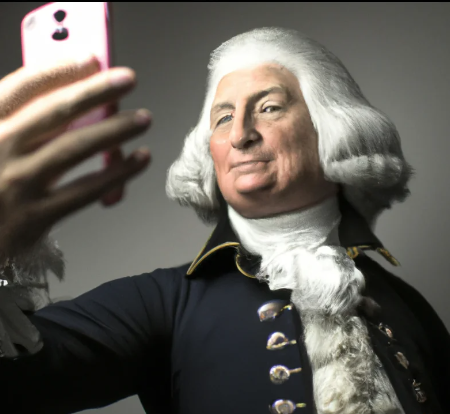The makeSPACE blog
Excellent work in the makeSPACE Foundation Course!
We thoroughly enjoy reading your Routine Adaptations as they come up for review. There are so many inspired ideas and great classroom insights. We thought we would share this particularly interesting adaptation from one of our Arts Rich Philadelphia teachers.
Remember, once you have finished a course you are always more than welcome to return. New teachers are sharing their imaginative classroom adaptations regularly.
Historical Selfies - Adapted from Selfies
Heather Kiszonas
Grade Level: 8
Subject: Social Studies
Problem of Practice - Students have difficulty understanding complex historical events, where there are multiple (more than 2) people or groups with differing interests, perspectives, and motivations, and when those motivations sometimes change.
Adaptation - Students create selfies to better understand the motivations and perspectives of the actors in an historical event. Instead of creating selfies about themselves, students will create selfies from the perspective of an assigned historical actor by gathering information (assigned readings and their own notes) about their assigned actor.
The questions the selfies answer might include, "How am I feeling about this situation that I am in?" , "What are my values?" , "What do I think would be the most fair outcome in this situation?". Students would be free to represent those answers as written explanations, cartoons, or drawings of metaphorical objects or colors. The only requirement is that they are able to explain the meaning of the selfie.
This is a two step process, as students initially work with an "alike" group to give them the opportunity to brainstorm and clarify their thinking about their actor. Each student will explain their selfie to their group and receive one piece of feedback from each group member.
The second step is to re-group into varied groups so that there is a representative of each historical actor in each group. Students would then "teach" their actor to their group by explaining their selfies to their new group.
Content-area learning objectives
Students will be able to explain the role that individuals and groups played in the development of the United States
Students will be able to explain how both conflict and cooperation between groups shaped (and continues to shape) the United States.
Students are developing storytelling and empathy skills as they deeply consider the perspective of an historical actor who, many times, will be quite different in perspective and experience from the student.
They are building creative thinking skills as they consider how they will represent this person with a selfie (or series of selfies).
They are participating in reflection within the feedback loop as they collaborate, re-consider, and refine their thinking.
Students are building their observation and listening skills as they consider each-others selfies.
Teacher Reflections - Students will benefit from using a variety of modalities to express the information in their selfies, especially allowing some students a greater sense of competency. Students will experience more autonomy in being able to choose the modality, as well as in collaboration and refining their thinking based on student-led questions and discussions.
Students will benefit from being able to present low-stakes selfies to their peers in small groups, adding to a sense of community and belonging.
I have often told my students that history is just a story. I remind them of how they can remember who said what to whom in an argument from last year! If we understand that historical actors are the same as us - they have emotions, and values and they act in ways that are consistent with those emotions and values - the history can become easy to remember and understand.
BUT, I've realized that I'm making an assumption about how good we all are at stories - listening to them, remembering them, finding meaning in them. For many students, that isn't their strength, and they don't think of the world in terms of a story. They need different ways of engaging with the material. The ways that these students learn, and the supports that they need, can really take me out of my comfort zone.
As I try to figure out how to help students who just aren't getting it, I feel like I'm trying keys in different doors. Sometimes the key works on some doors but it never works on all of the doors, and I have to find a new key. But I do believe there is a key out there for every door!
I started experimenting with selfies early in the year. Students created selfies during our community meeting time. Then I expanded their use to check in with students about their understanding in Social Studies. But I also wanted to see how I could use selfies to help with understanding content.
When we were learning about the fallout from the French and Indian War, many students struggled to understand the different sides and their perspectives and motivations, especially since the relationship between some groups shifted, and former allies become resentful of each other.
I thought it would help if students created selfies for each of the parties at two different points in time. For some students, this was clarifying. But for my students who consistently struggle in Social Studies, this really didn't help them that much. I was still having to prompt them as I conferenced with them, because they hadn't really made any new discoveries.
On reflection, I think the problem was that I was giving them too much to figure out on their own, and just hoping that the creative process would help them to come to a deeper understanding. This new approach includes students being responsible for only one actor, and then being able to present and discuss with their classmates so that they can learn from each other, and further clarify their own thinking.

